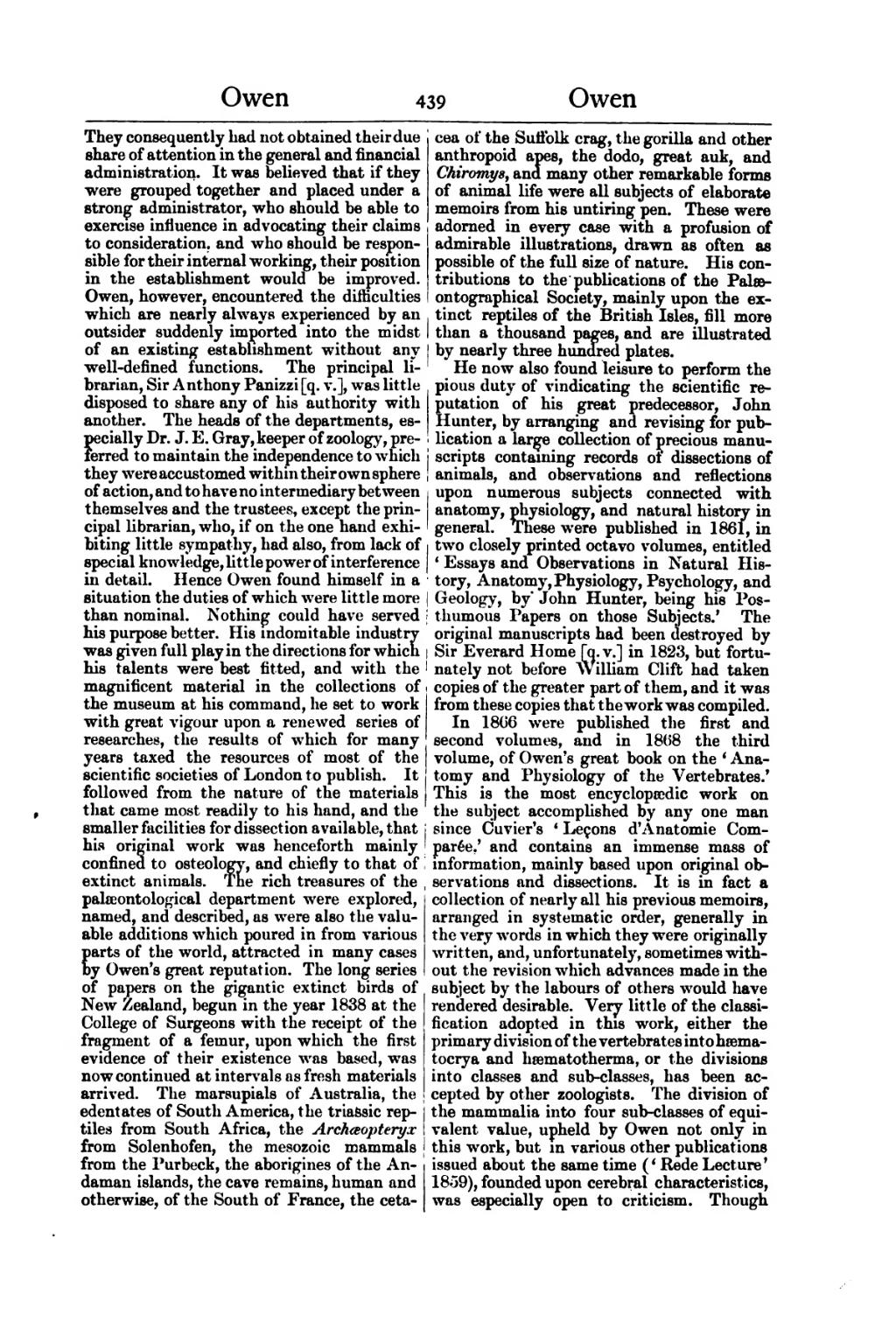They consequently had not obtained their due share of attention in the general and financial administration. It was believed that if they were grouped together and placed under a strong administrator, who should be able to exercise influence in advocating their claims to consideration, and who should be responsible for their internal working, their position in the establishment would be improved. Owen, however, encountered the difficulties which are nearly always experienced by an outsider suddenly imported into the midst of an existing establishment without any well-defined functions. The principal librarian, Sir Anthony Panizzi [q. v.], was little disposed to share any of his authority with another. The heads of the departments, especially Dr. J. E. Gray, keeper of zoology, preferred to maintain the independence to which they were accustomed within their own sphere of action, and to have no intermediary between themselves and the trustees, except the principal librarian, who, if on the one hand exhibiting little sympathy, had also, from lack of special knowledge, little power of interference in detail. Hence Owen found himself in a situation the duties of which were little more than nominal. Nothing could have served his purpose better. His indomitable industry was given full play in the directions for which his talents were best fitted, and with the magnificent material in the collections of the museum at his command, he set to work with great vigour upon a renewed series of researches, the results of which for many years taxed the resources of most of the scientific societies of London to publish. It followed from the nature of the materials that came most readily to his hand, and the smaller facilities for dissection available, that his original work was henceforth mainly confined to osteology, and chiefly to that of extinct animals. The rich treasures of the palæontological department were explored, named, and described, as were also the valuable additions which poured in from various parts of the world, attracted in many cases by Owen's great reputation. The long series of papers on the gigantic extinct birds of New Zealand, begun in the year 1838 at the College of Surgeons with the receipt of the fragment of a femur, upon which the first evidence of their existence was based, was now continued at intervals as fresh materials arrived. The marsupials of Australia, the edentates of South America, the triassic reptiles from South Africa, the Archæopteryx from Solenhofen, the mesozoic mammals from the Purbeck, the aborigines of the Andaman islands, the cave remains, human and otherwise, of the South of France, the cetacea of the Suffolk crag, the gorilla and other anthropoid apes, the dodo, great auk, and Chiromys, and many other remarkable forms of animal life were all subjects of elaborate memoirs from his untiring pen. These were adorned in every case with a profusion of admirable illustrations, drawn as often as possible of the full size of nature. His contributions to the publications of the Palæontographical Society, mainly upon the extinct reptiles of the British Isles, fill more than a thousand pages, and are illustrated by nearly three hundred plates.
He now also found leisure to perform the pious duty of vindicating the scientific reputation of his great predecessor, John Hunter, by arranging and revising for publication a large collection of precious manuscripts containing records of dissections of animals, and observations and reflections upon numerous subjects connected with anatomy, physiology, and natural history in general. These were published in 1861, in two closely printed octavo volumes, entitled ‘Essays and Observations in Natural History, Anatomy, Physiology, Psychology, and Geology, by John Hunter, being his Posthumous Papers on those Subjects.’ The original manuscripts had been destroyed by Sir Everard Home [q. v.] in 1823, but fortunately not before William Clift had taken copies of the greater part of them, and it was from these copies that the work was compiled.
In 1866 were published the first and second volumes, and in 1868 the third volume, of Owen's great book on the ‘Anatomy and Physiology of the Vertebrates.’ This is the most encyclopædic work on the subject accomplished by any one man since Cuvier's ‘Leçons d'Anatomie Comparée,’ and contains an immense mass of information, mainly based upon original observations and dissections. It is in fact a collection of nearly all his previous memoirs, arranged in systematic order, generally in the very words in which they were originally written, and, unfortunately, sometimes without the revision which advances made in the subject by the labours of others would have rendered desirable. Very little of the classification adopted in this work, either the primary division of the vertebrates into hæmatocrya and hæmatotherma, or the divisions into classes and sub-classes, has been accepted by other zoologists. The division of the mammalia into four sub-classes of equivalent value, upheld by Owen not only in this work, but in various other publications issued about the same time (‘Rede Lecture’ 1859), founded upon cerebral characteristics, was especially open to criticism. Though
